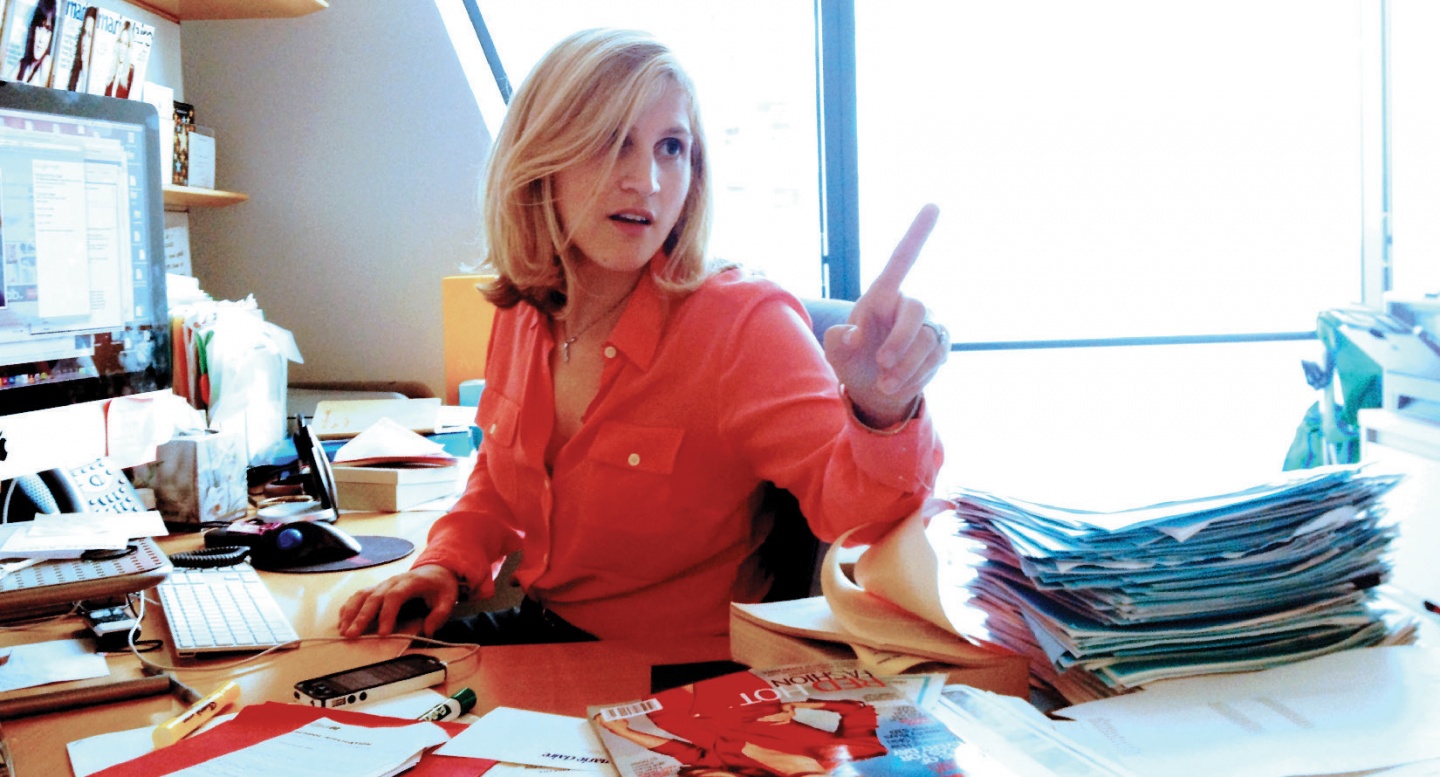Columbia College | Columbia University in the City of New York
Lea Goldman ’98 Is a Shot-caller Among Shot-callers
When Lea Goldman ’98 joined Marie Claire in 2008, there seemed to be a running cliché in women’s magazines: a credit card frozen in a block of ice.

SERGIO KLETNOV
“It was never the real stuff happening at work,” Goldman, now Marie Claire’s co-executive editor, says over lunch in the magazine’s Midtown headquarters. “Questions like ‘I just got a job offer. Am I just supposed to take the offer and be grateful?’ Or ‘How should I ask for more money?’ There were real questions people had — that I had, too — about work that were not acknowledged.”
Goldman’s answer to those questions was a section she started in the magazine in 2011 called “@Work,” about empowered women and their professional lives. It’s filled with profiles, advice and the ever-elusive definition of “business casual” fashion.
As a writer, editor, and television and web personality living in New Jersey with her husband and two young sons, Goldman embodies the values reflected in the section’s pages. She’s audacious, stylish and unabashedly successful.
“I have passions outside the office,” she says, “but my work is very important to me. I network my face off and love it. I’m trying to be as versatile as I see a lot of these women in the magazine are.”
Prior to joining Marie Claire as features and special projects editor, Goldman was hired at Forbesmagazine straight out of Columbia and worked her way up to senior editor. Along the way, she covered finance, wealth and entertainment, and compiled some of the magazine’s “Top 100” valuation lists.
Goldman studied literature at the College but admits she was more involved in extracurriculars, like student council, and was an RA. She co-founded the now highly anticipated annual Bacchanal festival, introducing to the stage a rapper you may have heard of named Busta Rhymes and a little band called Sonic Youth.
At Marie Claire, in addition to launching the @Work section, Goldman edited the magazine’s first column for plus-sized women. As a writer, she authored an expose, “The Big Business of Breast Cancer,” which won the James Aronson Award for Social Justice Journalism. This spring, she’ll appear regularly as an expert in a still-to-be-named reality TV show premiering on Oxygen about women entrepreneurs. As someone who believes that women should “toot their own horns,” Goldman is not shy about the grit required to achieve these feats.
“She is just so tough,” said Dennis Kneale, Goldman’s colleague at Forbes and now a media consultant. “She eats roofing nails for breakfast ... yet at the same time, she’s delightfully sardonic, she has such a sense of the absurd and she’s driven for high performance.”
Kneale, who was Forbes’ managing editor at the time Goldman worked there, recalls Goldman’s decision to put rapper 50 Cent on the magazine’s celebrity issue cover in 2004. Goldman recognized that the choice to feature him was edgy and captivating. “It scared the bejabbers out of our readers, but that was genius: taking something that was a culture story but realizing it was a finance story.”
Aside from writing and editing, Goldman is constantly looking for partnerships, knowing that “in this media world we live in now ... you have to wear many hats.” In 2013, after Goldman’s profile of NFL lawyer Anastasia Danias was published, Goldman helped launch a partnership with the league that would include the magazine running a 16-page spread on women sports fans. “No other women’s magazines were talking about the fact that on Monday morning, women were gathering and talking about ‘the game,’” she says. The league then added more clothing offerings for women and the magazine continued to devote more real estate to sports and fandom.
“What I love about Marie Claire, what speaks to me about the magazine, is that modern women can be as interested in fashion as they are about what’s happening in Europe right now, or the immigration crisis, or the presidential debates,” Goldman says. “For a long time, if you read women’s magazines, there was that tacit assumption that you weren’t reading The Wall Street Journal.”
As a result of her resourcefulness and eye toward the modern woman, Goldman rarely reads of credit cards in ice blocks but frequently of women who have long broken through glass ceilings and are ready to “rule the world,” she says. “What I’m most fascinated with is that I get to chronicle a revolution.”
Lauren Steussy covers Staten Island art and culture for the Staten Island Advance. Her last profile for CCT was on The Two Man Gentleman Band (Summer 2015). Her work has also appeared in San Diego Magazine and The Orange County Register.
Issue Contents
Published three times a year by Columbia College for alumni, students, faculty, parents and friends.
Columbia Alumni Center
622 W. 113th St., MC 4530, 4th Fl.
New York, NY 10025
212-851-7852
cct@columbia.edu
Columbia Alumni Center
622 W. 113th St., MC 4530, 4th Fl.
New York, NY 10025
212-851-7488
ccalumni@columbia.edu

